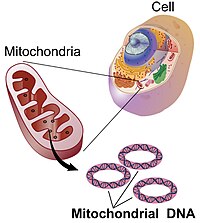
Photo from wikipedia
Background and Objective To characterize morphological and molecular underpinnings of polymyositis with mitochondrial pathology (PM-Mito) in comparison with sporadic inclusion body myositis (IBM) and to define common and distinct pathophysiologic… Click to show full abstract
Background and Objective To characterize morphological and molecular underpinnings of polymyositis with mitochondrial pathology (PM-Mito) in comparison with sporadic inclusion body myositis (IBM) and to define common and distinct pathophysiologic features with a focus on interferon (IFN)-associated inflammation and T-cell response. Methods In this cross-sectional study, skeletal muscle biopsy samples and clinical and laboratory data from patients with PM-Mito and IBM were analyzed at Charité university hospital in Berlin, Germany. All available PM-Mito biopsy samples, an equal number of randomly selected IBM biopsy samples, and randomly selected nondiseased controls (NDCs) were included in the study. Biopsy samples were studied by histopathology, immunohistochemistry, and quantitative PCR (qPCR) and compared with biopsies derived from NDCs. Primary outcomes included cell counts for immunohistochemistry and gene expression (fold-change values compared with those in NDCs) for qPCR. Results Twenty-five skeletal muscle biopsy samples of patients with PM-Mito and IBM were included in the study and compared with 5 biopsy samples from NDCs. PM-Mito and IBM qualitatively harbored a strikingly similar molecular signature and shared important histopathologic features. Expression of IFN-induced guanylate-binding protein (GBP)6 and T-cell function–related KLRG1 distinguished IBM from PM-Mito biopsies with IBM patients showing significantly higher expression of GBP6 and KLRG1. Cryptic exon expression was detected in both patient groups with IBM patients showing higher expression levels. Skeletal muscle biopsies from IBM patients showed significantly more GBP6+ cells and KLRG1+ lymphocytes in comparison with biopsies from patients with PM-Mito. CD45+, CD68+, CD57+, PD1+, and CD8+ cytotoxic T cells were also significantly more abundant in patients with IBM. Clinically, patients with PM-Mito presented with a spectrum of muscle-related symptoms including myalgia, proximal paraparesis, proximal tetraparesis, and incomplete IBM-like patterns. Thirteen of 14 (93%) patients with PM-Mito for whom clinical follow-up was available later developed clinically defined IBM. Notably, 2 follow-up biopsies obtained 5 and 7 years after the first ones were available in this cohort, both showing histopathologic progress to net IBM including GBP6 and KLRG1 upregulation. Discussion Our combined data suggest that specific IFN-mediated inflammation plays a key role in both IBM and PM-Mito. GBP6 was identified as a new molecule of type II IFN-induced inflammation distinguishing IBM from PM-Mito. Skeletal muscles from both groups harbor dysfunctional T cells of similar type, albeit in different quantity. T-cell senescence exemplified by KLRG1 positivity does not play a significant role in PM-Mito. Based on these findings, we propose to include PM-Mito in the spectrum of IBM (IBM-spectrum disease [IBM-SD]) as a possible early form of this disease. The establishment of IBM-SD as a larger entity could potentially have a significant effect on the design of trials and therapeutic interventions.
Journal Title: Neurology
Year Published: 2022
Link to full text (if available)
Share on Social Media: Sign Up to like & get
recommendations!